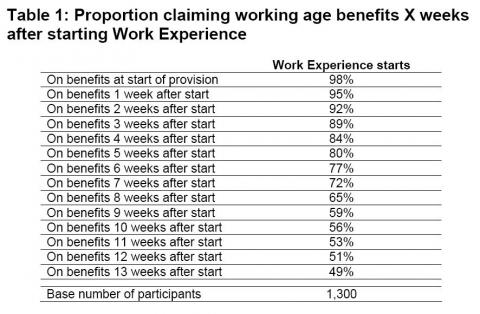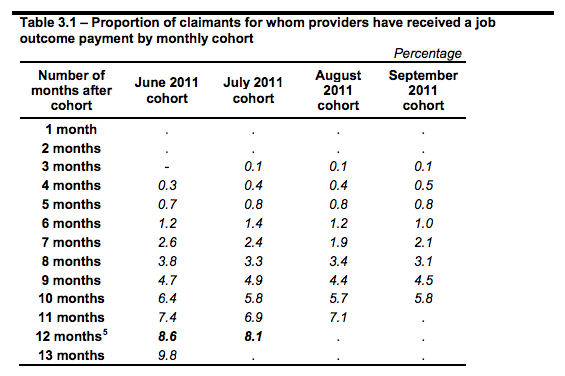Is the Government's work experience scheme "getting Britain working"?
"The enemies of workfare ignore the fact that it has been hugely successful elsewhere in returning people to the labour market — and that the early signs in Britain, too, are encouraging." The Telegraph, February 13, 2013
"All the statistics released about the Work Programme show execrable results, and yet we've heard nothing about penalties, or remaking the contracts, or rethinking the system. " The Guardian, February 13, 2013
This week geology graduate Cait Reilly and former HGV driver Jamieson Wilson successfully argued that their Job Seeker's Allowance (JSA) was unlawfully withdrawn when they refused to undertake work placements.
This is prompted a lot of analysis on whether the government's 'Get Britain Working' policy has been producing the desired outcomes.
Join 72,953 people who trust us to check the facts
Sign up to get weekly updates on politics, immigration, health and more.
Subscribe to weekly email newsletters from Full Fact for updates on politics, immigration, health and more. Our fact checks are free to read but not to produce, so you will also get occasional emails about fundraising and other ways you can help. You can unsubscribe at any time. For more information about how we use your data see our Privacy Policy.
Ms Reilly was particularly damning of her experience of the scheme, saying her placement at budget retailer Poundland was "a complete waste of time." But is this symptomatic of the scheme, and others like it, or have other claimants found it useful? Let's see what the statistics tell us.
A number of measures were launched in January 2011 as part of the Government's drive to encourage out-of-work benefits claimants to gain experience of the jobs market. These include the Jobcentre Plus offer, the Get Britain Working measures, the Work Programme and the Support for the Long Term Unemployed Trailblazer. Each scheme is tailored to different circumstances and needs.
Cait Reilly undertook the Sector-Based Work Academy (SBWA), a scheme that is initially voluntary (but incurs penalties for withdrawal) which aims to provide a short period of work-focused training and work experience linked to a job vacancy. Mr Wilson, on the other hand, took part in the Community Action Programme ("CAP"), a scheme for the very long-term unemployed, which provides work placements for up to 6 months and is part of the Trailblazer package.
So what can we conclude about the success of these various schemes?
This morning the DWP released official statistics on work experience starts. While the number of starts has increased from 70 in January 2011 to 6,440 in November 2012, this doesn't necessarily tell us anything about whether the policy is working.
Full Fact looked into this last year. At that point, we found that "13 weeks after starting the placements, 49 per cent of the participants were on working age benefits". (Source: DWP Early Analysis of Work Experience participant outcomes)

What we can't tell from these figures is the extent to which the work experience scheme has improved the prospects for those looking for work, as we don't know how many of these jobseekers would have gained employment or otherwise stopped claiming benefits over the same period.
However, last year the DWP commissioned the National Institute for Economic and Social Research (NIESR) to peer review the outcomes for jobseekers which did broach this problem.
The report compared 3,490 19 to 24-year-olds "who took part in work experience with a group of Jobseeker's Allowance claimants from the same age group with similar characteristics, employment and benefit histories who did not take up the placement."
Its main finding was that:
"the first 3,490 young people who took part in the Government placements were 16% more likely to be off benefits 21 weeks after starting than those in a similar group who did not take part."
Overall, 8 weeks after starting, participants were more likely to be in employment than non-participants, as shown in the table below. The report also added that "it is difficult to tell whether this is a true empirical finding or a result of the imprecision of the employment data, so some caution should be attributed to this particular observation."

While this review of the scheme seems to be cautiously positive, there is also evidence that it is failing to meet the target set for it by the Employment Minister Chris Grayling. Indeed the National Audit Office reported last year that the DWP had been "over optimistic" in forecasting that 40% more people will get back into work as a result of the scheme, and neither the NAO - who recorded a 26% improvement - nor DWP/NIESR saw anything like this scale of improvement.
A November 2012 statistical release on the Work Programme (WP) revealed that out of 878,000 referrals, "the total number of job outcomes paid to providers from 1st June 2011 to the end of July 2012 is 31,000". This means that 3.5%, of participants were ending the scheme with a job lasting six months or more, which is some way below the DWP's 5.5% target.
When the DWP first invited employers to participate in the scheme, it argued that it would be considered a success if it increased the likelihood of a participant getting a job by 10% or more. The DWP estimated that 5% of jobseekers would find work in a year outside of the scheme, meaning that the Department expected 5.5% of Work Programme participants to find work over the same period, a benchmark it failed to meet.
However while the Government measures its success in terms of a simple ratio between the number of 'job outcomes' against the number of people being referred to the scheme, we shouldn't assume that, on an individual level only 3.5% of participants are finding work after a year on the scheme. This is because at any given point, only a fraction of the people referred to the scheme over a 12 moth period will have been participating for a whole year, and many will have been referred relatively recently.
As the statistical release showed, the DWP has actually tracked the proportion of particular cohorts of participants that have found work on a monthly basis as they prgress through the scheme, and found that after a year, over 8% of people had found work for six months or more in the two samples that have reached that milestone so far.

In terms of the Jamieson Wilson's specific case, according to one DWP Research summary thanks to the Support for the Very Long-Term Unemployed (SVLTU) scheme, "15 to 18% in each programme strand had entered paid employment, become self-employed or were waiting to start work at the time of the survey, six to seven months after starting on the trailblazer."
While this success rate might not seem too promising, the DWP argues that there is evidence that the programme helped increase claimants' confidence:
"76% felt they had gained satisfaction from being in a routine while on their placement and 69% cited a sense of achievement."
So while the DWP plans to publish more data on participant outcomes within the year, it remains perhaps too early to conclude as the Telegraph the Guardian have done that the scheme has been either "hugely success" or "showing execrable results". With the information that we have now, and depending on which scheme we decide to focus on, there is evidence to argue both sides of this debate.
---
Flickr images courtesy of hazelisles